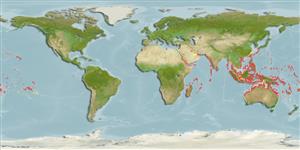Preferred temperature (Ref.
115969): 25 - 29.3, mean 28.3 (based on 3073 cells).
Phylogenetic diversity index (Ref.
82804): PD
50 = 0.5000 [Uniqueness, from 0.5 = low to 2.0 = high].
Bayesian length-weight: a=0.01047 (0.00607 - 0.01808), b=3.16 (3.01 - 3.31), in cm Total Length, based on LWR estimates for this species & Genus-body shape (Ref.
93245).
栄養段階 (Ref.
69278): 3.2 ±0.2 se; based on diet studies.
回復力 (Ref.
120179): 高い, 15か月以下の倍増期間の最小個体群 (K=0.7).
Fishing Vulnerability (Ref.
59153): Low vulnerability (20 of 100).
